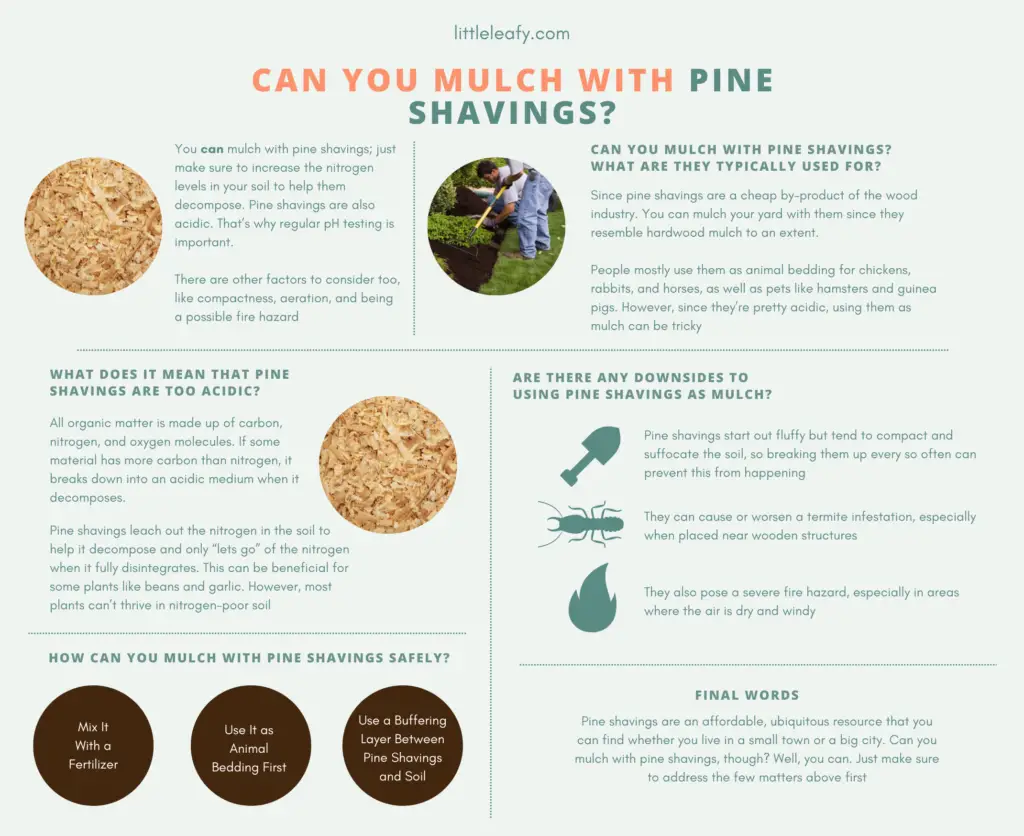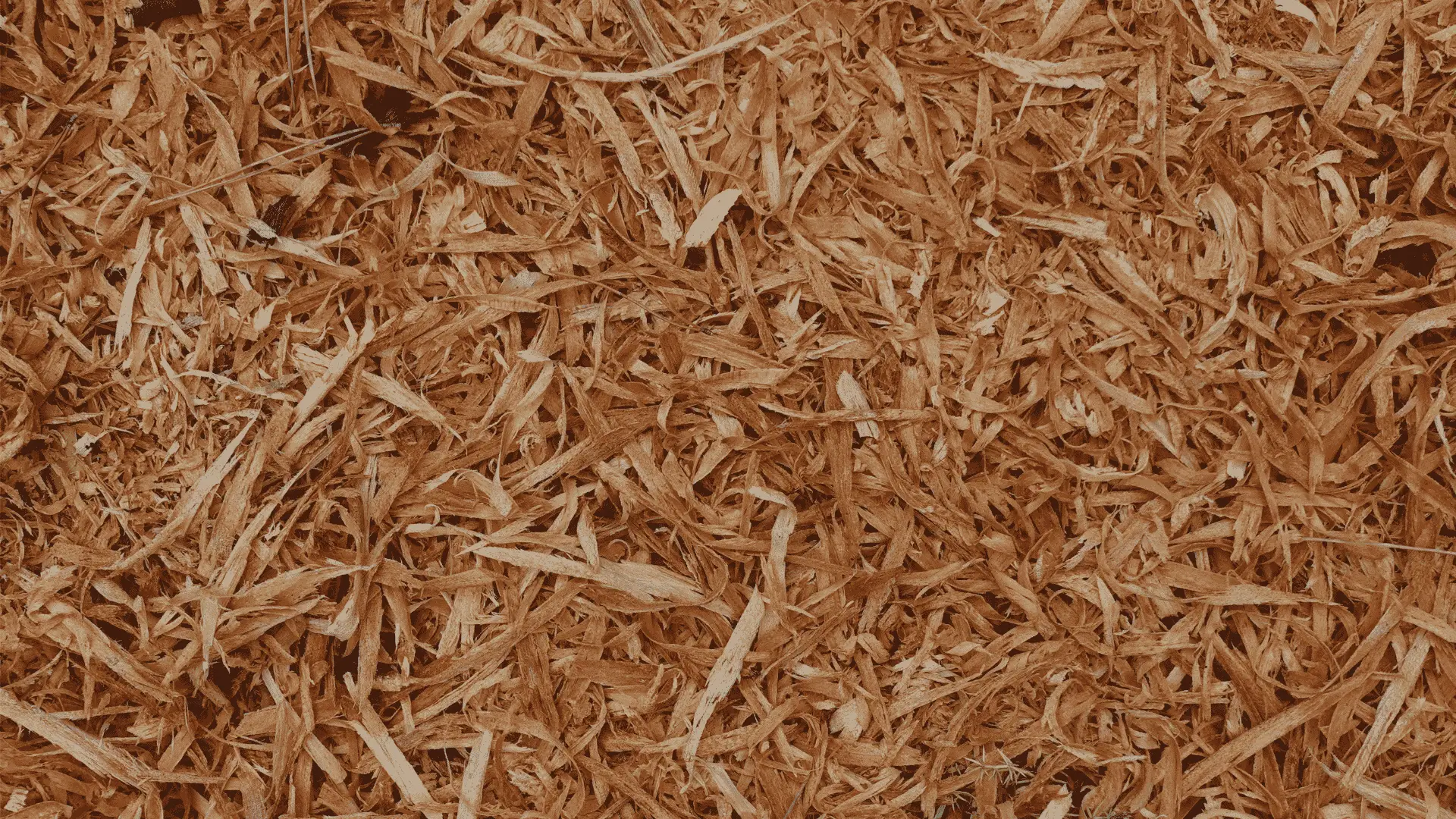Reading Time: 4 minutes 🍃
Pine shavings are used for many things, the most common of which is animal bedding. However, since they look and feel a lot like it, can you mulch with pine shavings?
You can mulch with pine shavings; just make sure to increase the nitrogen levels in your soil to help them decompose. Pine shavings are also acidic, so they tend to make the soil’s pH drop. That’s why regular pH testing is important.
There are other factors to consider if you want to mulch with pine shavings, like compactness, aeration, and being a possible fire hazard. So, let’s go over them and find out when mulching with pine shavings is a good idea and when it’s not.

Can You Mulch With Pine Shavings? What Are They Typically Used For?
Since pine shavings (or sawdust) are a cheap byproduct of the wood industry, they’re a commonplace finding at the hardware store. You can mulch your yard with them since they resemble hardwood mulch to an extent, providing weed suppression and sun protection.
People mostly use them as animal bedding for chickens, rabbits, and horses, as well as pets like hamsters and guinea pigs. They can also be used as part of the growing medium for certain crops. However, since they’re pretty acidic, using them as mulch can be tricky.
What Does It Mean That Pine Shavings Are Too Acidic?
Pine shavings are notorious for being “too acidic” to be used in soil, but what exactly does this mean?
Well, all organic matter is made up of carbon, nitrogen, and oxygen molecules. If some material has more carbon than nitrogen, it breaks down into an acidic medium when it decomposes. So, the carbon seeks out nitrogen molecules to neutralize this acidity.
Now, let’s apply this to pine shavings. If used as a soil additive, pine shavings leach out the nitrogen in the soil to help it decompose and only “lets go” of the nitrogen when it fully disintegrates. This can be beneficial for some plants that require an acidic growing medium, like beans and garlic.
However, most plants can’t thrive in nitrogen-poor soil. That’s why there are some things you can do to make pine shavings mulch work for you. So let’s go over some of the ways you can utilize pine shavings in your garden without harming your plants.
How Can You Mulch With Pine Shavings Safely?
As we previously mentioned, pine shavings are dirt cheap. A huge bale that covers over 10 square feet can set you back very little. So, here are some ways you can mulch with pine shavings without hurting your soil’s nitrogen reserves.
Use It as Animal Bedding First
This is a neat trick if you want to make the most out of your pine shavings. Just use them as animal bedding before you mulch with them.
Animal manure, urine, and bird droppings are rich in urea, which is a compound made of ammonia and water. Well, ammonia is a nitrogenous compound commonly used in fertilizers, so you’re getting your fertilizer right from the natural source!
Leave the bedding in the chicken coop or stable for as long as you usually do, then take it out and spread it on the soil evenly. Just make sure not to compact it too heavily, as it can suffocate new growth.
Mix It With a Fertilizer
If you don’t keep animals (or are grossed out by the idea of using chicken poop on your vegetables), you can just use fertilizer !
!
Now, you have to do a little bit of math here. Every 50 lbs of pine shavings have to be mixed with 1 lb of actual nitrogen. Since fertilizer isn’t just pure nitrogen, you have to calculate the percentage of nitrogen in the fertilizer and use it accordingly.
Since nitrogenous fertilizers vary in their formula , you should be aware of the concentration that you have on hand.
, you should be aware of the concentration that you have on hand.
For example, every 3 lbs of ammonium nitrate have 1 lb of actual nitrogen because ammonium nitrate is roughly 33.5% nitrogen. This means that for every 50 lb bag of pine shavings, you add 3 lbs of ammonium nitrate to get the desired effect.
This will more than make up for the amount of nitrogen needed to break down the pine shavings and prevent unduly soil acidity.
Use a Buffering Layer Between the Pine Shavings and the Soil
The biggest problem when it comes to increased soil acidity only happens when the pine shavings are tilled into the soil. The moisture from the soil releases the carbon molecules in the sawdust and reduces the soil pH.
So, if you add another layer of mulch between the pine shavings and the soil, you can reap their soil-aerating, weed-suppressing benefits without the extra acidity.
Are There Any Downsides to Using Pine Shavings as Mulch?
As great as they can be, pine shavings still have some disadvantages when used as mulch, especially over a large area of your yard. Here are some issues to look out for:
when used as mulch, especially over a large area of your yard. Here are some issues to look out for:
- Pine shavings start out fluffy but tend to compact and suffocate the soil, so breaking them up every so often can prevent this from happening. After they decompose completely, you can safely incorporate them into the soil.
- They can cause or worsen a termite infestation, especially when placed near wooden structures. Leave at least a one ft. border around the house or barn un-mulched if you intend to mulch with any kind of wood shavings.
- They also pose a severe fire hazard, especially in areas where the air is dry and windy. Dry pine shavings are basically fire kindling, so to avoid that, moisten them regularly with a garden hose.
Conclusion
Pine shavings are an affordable, ubiquitous resource that you can find whether you live in a small town or a big city. Can you mulch with pine shavings, though? Well, you can. Just make sure to address a few matters first.
The acidity they impart on the soil and nitrogen depletion can be neutralized using animal droppings or fertilizer. As for other problems like compactness, an occasional raking will break them up well enough.
Just make sure to spread the shavings away from wooden structures to minimize the possibility of a termite infestation. What’s more, remember to keep them slightly damp in areas with high wind activity to reduce their chances of catching fire.
Sources
- https://www.gardeningknowhow.com/garden-how-to/mulch/using-sawdust-as-mulch.htm

- https://njaes.rutgers.edu/FS839/

- https://homeguides.sfgate.com/disadvantages-wood-shavings-mulch-47586.html




